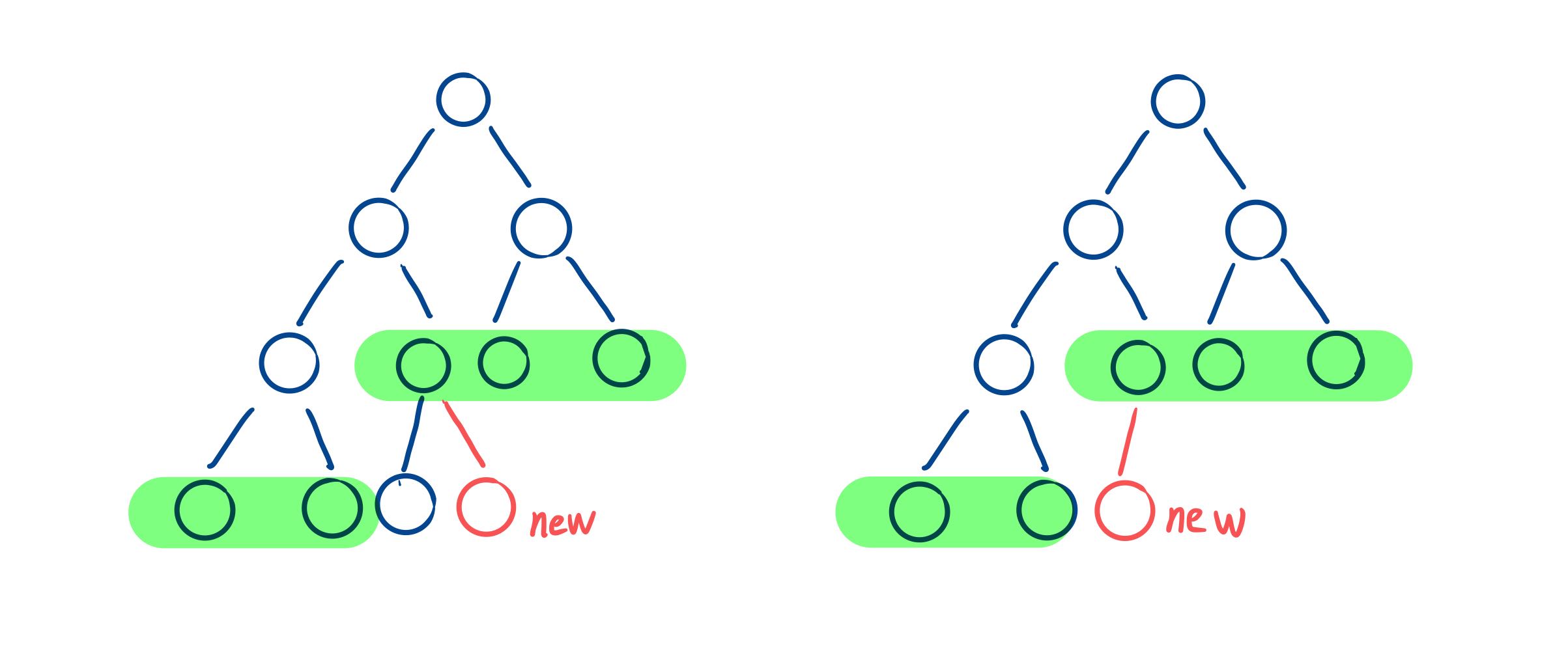二叉搜索树相关
# 0x01 二叉树最底层最左边的值给定一个二叉树的 根节点 root ,请找出该二叉树的 最底层 最左边 节点的值。
假设二叉树中至少有一个节点。
1 2 输入: [1,2,3,4,null,5,6,null,null,7] 输出: 7
# 法一:前序遍历 DFS使用 DFS 递归遍历树的所有节点,记录当前节点的层级 level 与已遍历节点的最大层级 maxLevel
遍历到新的一层的第一个节点为最底层,最左边的节点
1 2 3 4 5 6 7 8 9 10 11 12 13 14 15 16 17 18 19 class Solution {public : int res = 0 ; int maxlevel=-1 ; int findBottomLeftValue (TreeNode* root) dfs (root,0 ); return res; } void dfs (TreeNode * root,int level) if (root==NULL ) return ; if (level>maxlevel){ res = root->val; maxlevel = level; } dfs (root->left,level+1 ); dfs (root->right,level+1 ); } };
# 法二:层序遍历 BFS更新每层第一个元素值,取最后一次更新值
1 2 3 4 5 6 7 8 9 10 11 12 13 14 15 16 17 18 19 20 21 22 23 24 25 26 27 28 29 30 31 class Solution {public : int findBottomLeftValue (TreeNode* root) queue<TreeNode*> q; q.push (root); int leftnode; while (!q.empty ()){ int size = q.size (); for (int i=size;i;i--){ auto node = q.front (); if (i==size) leftnode = node->val; q.pop (); if (node->left) q.push (node->left); if (node->right) q.push (node->right); } } return leftnode; } };
# 0x02 往完全二叉树添加节点完全二叉树是每一层(除最后一层外)都是完全填充(即,节点数达到最大,第 n 层有 2n-1 个节点)的,并且所有的节点都尽可能地集中在左侧。
设计一个用完全二叉树初始化的数据结构 CBTInserter,它支持以下几种操作:
CBTInserter (TreeNode root) 使用根节点为 root 的给定树初始化该数据结构;
示例 1:
1 2 3 4 5 6 输入:inputs = ["CBTInserter" ,"insert" ,"get_root" ], inputs = [[[1 ]],[2 ],[]] 输出:[null ,1 ,[1 ,2 ]] 输入:inputs = ["CBTInserter" ,"insert" ,"insert" ,"get_root" ], inputs = [[[1 ,2 ,3 ,4 ,5 ,6 ]],[7 ],[8 ],[]] 输出:[null ,3 ,4 ,[1 ,2 ,3 ,4 ,5 ,6 ,7 ,8 ]]
# 使用队列完成二叉树的层序遍历通过观察可以发现新节点需要插入层次遍历时第一个出现的 “不完整的节点” (即不同时具有左右孩子节点)。如图中所示,绿色代表当前队列中的节点(规定节点的左右孩子均存在时才将它们一起先后压入队列),当遍历到 “不完整的节点” 就找到了新节点插入的节点位置,“不完整的节点” 位于队列的头部。在 CBTInserter 函数中实现该过程,找到插入的位置,以及得到当前的队列。
插入操作时,先后检查队列头部节点的左右孩子,若左孩子缺失则将新节点插入其左孩子,右孩子缺失则插入右孩子。当队列头部节点的左右孩子都存在,则将其左右孩子压入队列尾部,队列的头部节点出队列,因为此时它已不是 “不完整的节点” 。更新后的队列的头部节点将是下一个 “不完整的节点”。按照规则依次处理接下来的插入操作。
1 2 3 4 5 6 7 8 9 10 11 12 13 14 15 16 17 18 19 20 21 22 23 24 25 26 27 28 29 30 31 32 33 34 35 36 37 38 39 40 41 42 43 44 45 46 47 48 49 50 51 52 53 class CBTInserter {private : queue<TreeNode*> que; TreeNode* root; public : CBTInserter (TreeNode* root) { this ->root = root; que.push (root); while (que.front ()->left != nullptr && que.front ()->right != nullptr ) { que.push (que.front ()->left); que.push (que.front ()->right); que.pop (); } } int insert (int v) TreeNode* node = new TreeNode (v); TreeNode* fa = que.front (); if (fa->left == nullptr ) { fa->left = node; } else { fa->right = node; que.push (fa->left); que.push (fa->right); que.pop (); } return fa->val; } TreeNode* get_root () { return this ->root; } };
时间复杂度为 O (n),队列中存的节点数为 O (n),所以空间复杂度为 O (n)。









